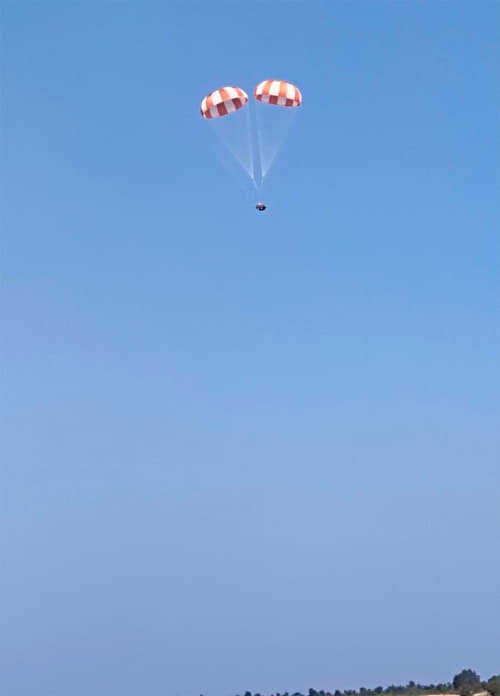It was an unusual morning for the residents of the small cantonment town of Babina on the outskirts of Jhansi as they saw two giant colourful parachutes descending through a foggy November sky. The parachutes later turned out to be the same parachutes that would help the astronauts of the country’s first human spaceflight return to earth safely after completing their mission in space.
On Friday, Vikram Sarabhai Space Centre, the lead centre for Gaganyaan activities conducted a major development test of its crew module deceleration system at the Babina Field Fire Range (BFFR) in the Jhansi district of Uttar Pradesh. The Integrated Main Parachute Airdrop Test, or IMAT, marks a significant milestone toward realizing the nation’s ambitious Gaganyaan project.

The Gaganyaan deceleration system consists of three main parachutes, besides the smaller ACS, pilot, and drogue parachutes, to reduce the speed of the crew module to safe levels during its landing. Two of the three main chutes are sufficient to land the astronauts on earth, and the third is redundant. The IMAT test simulated the case when one main chute failed to open. The IMAT test is the first in a series of integrated parachute airdrop tests planned to simulate different failure conditions of the parachute system before it is deemed qualified to be used in the first human spaceflight mission.
In this test, a 5-ton dummy mass, equivalent to the crew module mass, was taken to an altitude of 2.5 kilometres and dropped using the Indian Air force’s IL-76 aircraft. Two small pyro-based mortar-deployed pilot parachutes then pulled the main parachutes. The main parachute sizes were initially restricted to a smaller area to reduce the opening shock. After 7 seconds, the pyro-based reefing line cutters cut the area restricting line, allowing the parachutes to inflate fully. The fully inflated main parachutes reduced the payload speed to a safe landing speed. The entire sequence lasted about 2-3 minutes as the scientists watched the different phases of the deployment sequence unfold with bated breath. There was loud cheer and applause as the payload mass landed softly on the ground and the gigantic parachutes collapsed.
The design and development of the parachute based deceleration system is a joint venture of Indian Space Research Organisation and the Defence Research and Development Organization. The overall system design, analytical simulations of parachute deployment and crew module descent under various conditions, the design and development of ordnance devices for parachute extraction and ejection, assembly/mechanical & electrical integration of deceleration system, it’s instrumentation and avionics for conducting this drop tests are done by Vikram Sarabhai Space Centre (VSSC), Thiruvananthapuram, one of the leading R&D centre of ISRO.
Senior ISRO and DRDO scientists and air force officers were present to witness this crucial test. “Besides proving the calibre of the scientists of ISRO and DRDO, the test also demonstrated the active coordination between the country’s premier agencies, namely ISRO, DRDO, the Indian air force, and the Indian Army,” a senior official present during the test said.
The Gaganyaan parachute system consists of a total of 10 no. of parachutes. Each parachute’s performance must be evaluated by complex testing methods using aircraft and helicopters. A total of five nos. of airdrop tests are planned at BFFR as part of the qualification of the Gaganyaan main parachute system. “The next test lined up at BFFR is to demonstrate the lead-lag deployment of clustered main parachutes using 5-tonne payload”, the space agency reported.
Source: ISRO